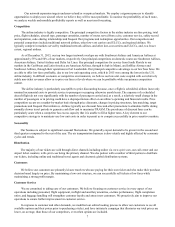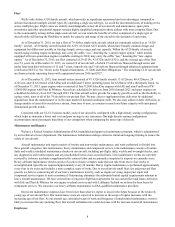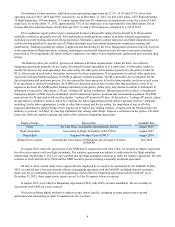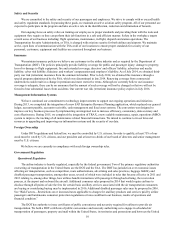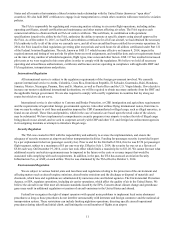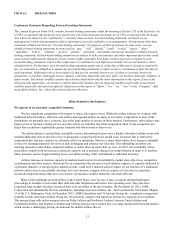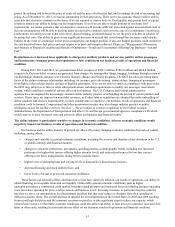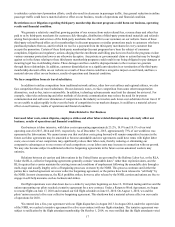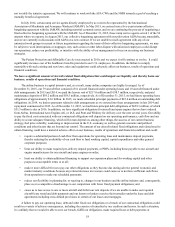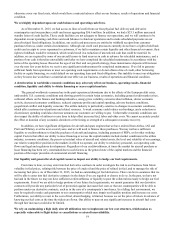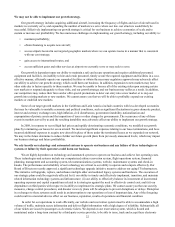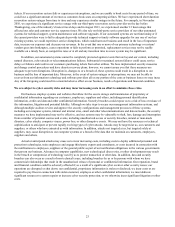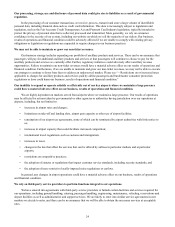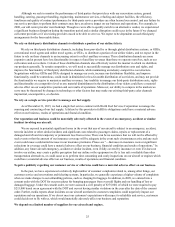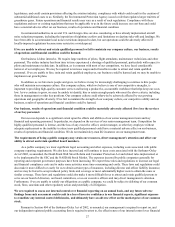Spirit Airlines 2015 Annual Report Download - page 17
Download and view the complete annual report
Please find page 17 of the 2015 Spirit Airlines annual report below. You can navigate through the pages in the report by either clicking on the pages listed below, or by using the keyword search tool below to find specific information within the annual report.17
to subsidize certain travel promotion efforts, could also result in decreases in passenger traffic. Any general reduction in airline
passenger traffic could have a material adverse effect on our business, results of operations and financial condition.
Restrictions on or litigation regarding third-party membership discount programs could harm our business, operating
results and financial condition.
We generate a relatively small but growing portion of our revenue from order referral fees, revenue share and other fees
paid to us by third-party merchants for customer click-throughs, distribution of third-party promotional materials and referrals
arising from products and services of the third-party merchants that we offer to our customers on our website. Some of these
third-party referral-based offers are for memberships in discount programs or similar promotions made to customers who have
purchased products from us, and for which we receive a payment from the third-party merchants for every customer that
accepts the promotion. Certain of these third-party membership discount programs have been the subject of consumer
complaints, litigation and regulatory actions alleging that the enrollment and billing practices involved in the programs violate
various consumer protection laws or are otherwise deceptive. Any private or governmental claim or action that may be brought
against us in the future relating to these third-party membership programs could result in our being obligated to pay damages or
incurring legal fees in defending claims. These damages and fees could be disproportionate to the revenues we generate
through these relationships. In addition, customer dissatisfaction or a significant reduction in or termination of the third-party
membership discount offers on our website as a result of these claims could have a negative impact on our brand, and have a
material adverse effect on our business, results of operations and financial condition.
We face competition from air travel substitutes.
In addition to airline competition from traditional network airlines, other low-cost airlines and regional airlines, we also
face competition from air travel substitutes. On our domestic routes, we face competition from some other transportation
alternatives, such as bus, train or automobile. In addition, technology advancements may limit the demand for air travel. For
example, video teleconferencing and other methods of electronic communication may reduce the need for in-person
communication and add a new dimension of competition to the industry as travelers seek lower-cost substitutes for air travel. If
we are unable to adjust rapidly in the event the basis of competition in our markets changes, it could have a material adverse
effect on our business, results of operations and financial condition.
Risks Related to Our Business
Increased labor costs, union disputes, employee strikes and other labor-related disruption may adversely affect our
business, results of operations and financial conditions.
Our business is labor intensive, with labor costs representing approximately 23.2%, 19.9% and 19.1% of our total
operating costs for 2015, 2014 and 2013, respectively. As of December 31, 2015, approximately 73% of our workforce was
represented by labor unions. We cannot assure you that our labor costs going forward will remain competitive because in the
future our labor agreements may be amended or become amendable and new agreements could have terms with higher labor
costs; one or more of our competitors may significantly reduce their labor costs, thereby reducing or eliminating our
comparative advantages as to one or more of such competitors; or our labor costs may increase in connection with our growth.
We may also become subject to additional collective bargaining agreements in the future as non-unionized workers may
unionize.
Relations between air carriers and labor unions in the United States are governed by the Railway Labor Act, or the RLA.
Under the RLA, collective bargaining agreements generally contain “amendable dates” rather than expiration dates, and the
RLA requires that a carrier maintain the existing terms and conditions of employment following the amendable date through a
multi-stage and usually lengthy series of bargaining processes overseen by the NMB. This process continues until either the
parties have reached agreement on a new collective bargaining agreement, or the parties have been released to “self-help” by
the NMB. In most circumstances, the RLA prohibits strikes; however, after release by the NMB, carriers and unions are free to
engage in self-help measures such as lockouts and strikes.
Our flight operations were shut down due to a strike by our pilots beginning on June 12, 2010 and lasting until we and the
union representing our pilots reached a tentative agreement for a new contract. Under a Return to Work Agreement, we began
to resume flights on June 17, 2010 and resumed our full flight schedule on June 18, 2010. On August 1, 2010, we and the
pilots’ union executed a five-year collective bargaining agreement. This shutdown had a material adverse effect on our results
of operations for 2010.
We entered into a five-year agreement with our flight dispatchers in August 2013. In August 2014, under the supervision
of the NMB, we reached a tentative agreement for a five-year contract with our flight attendants. The tentative agreement was
subject to ratification by the flight attendant membership. On October 1, 2014, we were notified that the flight attendants voted


